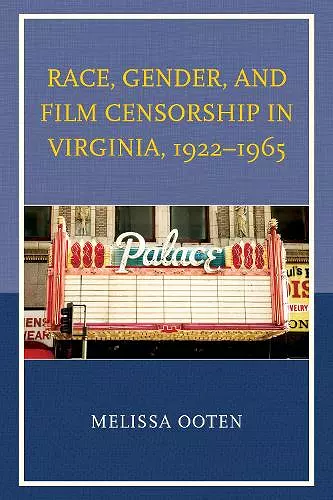Race, Gender, and Film Censorship in Virginia, 1922–1965
Format:Hardback
Publisher:Lexington Books
Published:18th Dec '14
Currently unavailable, and unfortunately no date known when it will be back

This book chronicles the history of movie censorship in Virginia from the 1920s to 1960s. At its most basic level, it analyzes the project of state film censorship in Virginia. It uses the contestations surrounding film censorship as a framework for more fully understanding the dominant political, economic, and cultural hierarchies that structured Virginia and much of the New South in the mid-twentieth century and ways in which citizens contested these prevailing structures. This study highlights the centrality of gendered and racialized discourses in the debates over the movies and the broader regulatory power of the state. It particularly emphasizes ways in which issues of race, class, gender, and sexuality framed debates over popular culture in the South. It ties the regulation of racial and sexual boundaries in other areas such as public facilities, schools, public transportation, the voting booth, and residential housing to ways in which censors regulated those same boundaries in popular culture. This book shows how the same racialized and gendered social norms and legal codes that placed audience members in different theater spaces also informed ways in which what they viewed on-screen had been mediated by state officials. Ultimately, this study shows how Virginia’s officials attempted to use the project of film censorship as the cultural arm of regulation to further buttress the state’s political and economic hierarchies of the time period and the ways in various citizens and community groups supported and challenged these hierarchies across the censorship board’s forty-three-year history.
The growing scholarship of film censorship in America, and particularly, in the Jim Crow South sheds important light on the complex relationship between governance and popular culture. Melissa Ooten’s thorough study, Race, Gender, and Film Censorship in Virginia, 1922– 1965, is a welcome addition. . . .She convincingly argues that issues regarding not only race but also gender, sexuality, and class informed Virginia’s movie censorship. . . .Ooten’s examination of how discourses of race and gender informed Virginia’s censorship board is a vital contribution to understanding cinema and its exhibition in the Jim Crow South. * Virginia Magazine of History and Biography *
Ooten's Race, Gender, and Film Censorship in Virginia sheds light on the importance and relevance of film in shaping a hierarchical, racialized, and gendered society. It offers an interesting vantage point from which to view white supremacy and southern history. * The Journal of African American History *
Melissa Ooten not only illuminates the tangled intersections of race, gender, sexuality, and class in Virginia’s movie censorship program, but also deftly explores the public discourse and debates regarding state, local, and individual power over access to cultural texts. This study adds an important layer to our understanding of film as a tool to both extend and challenge hegemonic power within the context of Jim Crow Virginia. With its focus on state and local contexts, Race, Gender, and Film Censorship in Virginia is a significant addition to the literature on race and film and would be an excellent text for courses on film or American Studies. -- Sarah Trembanis, Immaculata University
Ooten artfully tells the story of civil rights through the lens of film censorship in Virginia. The greatest strength of this fine book lies in the way Ooten recovers the voices of Virginians—farmers, ministers, politicians, and mothers—as they debated film censorship, the meaning of race and sex in film—and ultimately, wrestled with their own approach to modernity. Her thorough archival research reveals in rich detail how Virginia’s film censors used their powers to maintain racial hierarchies through regulating images of African Americans on screen—and how those censors struggled against African American film makers and activists who campaigned against white supremacy. -- Laura Browder, University of Richmond
Ooten’s book takes an illuminating and fascinating look at Virginia’s engagement with film censorship from the 1920s to the mid-1960s. With significant breadth and depth, Ooten considers how film censorship emerged out of a desire to protect “vulnerable” populations – children, white women, and black men and women – from the “dangers” of the allegedly immoral culture of Hollywood. Virginia was one of the states that elected to have a state censorship board to preview and approve all of the films shown in the state. Ooten demonstrates the desire of the censorship board – with the blessing of those who could vote – to uphold racial purity by “protecting” white women, and to reduce or eliminate black progress by forbidding or cutting films that portrayed blacks as anything other than a permanently (and happily) inferior race. The book tracks the changes in depictions of blacks and in actual race relations from the 1920s to the mid-1960s, as well as changes in representations of women and women’s sexuality in film over the same period. Ooten successfully demonstrates that the effect of censorship was to shore up white middle-class hegemony. -- Lisa Anderson, Arizona State University
ISBN: 9780739190296
Dimensions: 237mm x 164mm x 22mm
Weight: 467g
220 pages